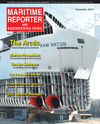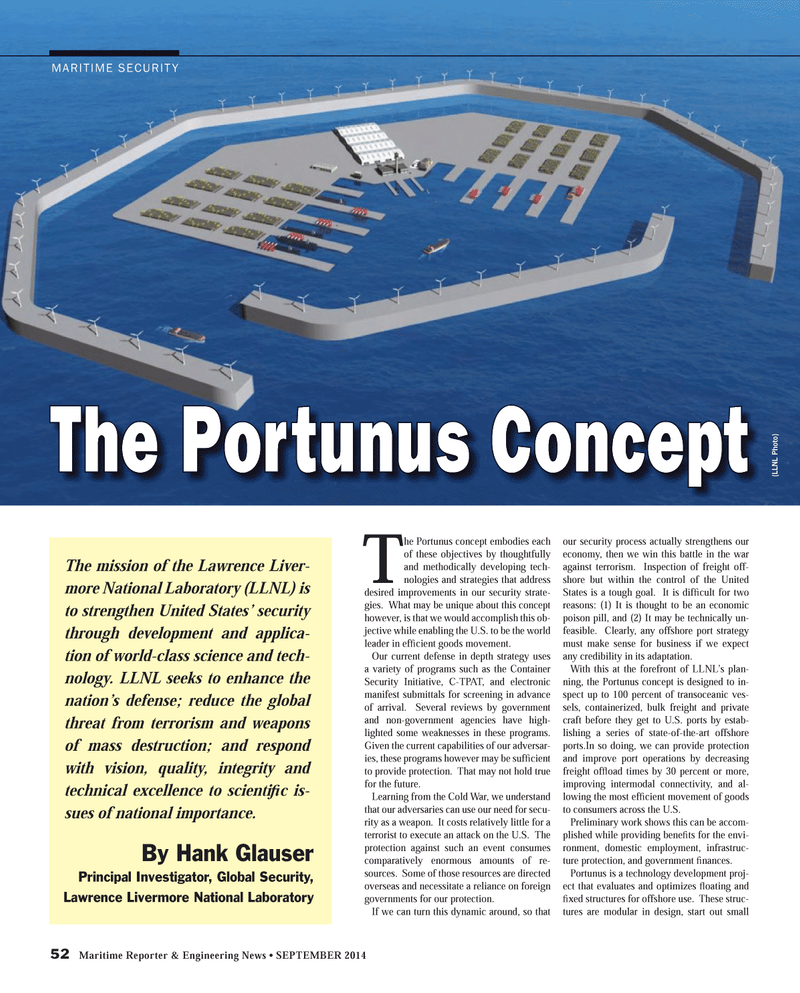
Page 52: of Maritime Reporter Magazine (September 2014)
Marine Propulsion Edition
Read this page in Pdf, Flash or Html5 edition of September 2014 Maritime Reporter Magazine
52 Maritime Reporter & Engineering News • SEPTEMBER 2014
MARITIME SECURITY
T he Portunus concept embodies each of these objectives by thoughtfully and methodically developing tech- nologies and strategies that address desired improvements in our security strate- gies. What may be unique about this concept however, is that we would accomplish this ob- jective while enabling the U.S. to be the world leader in effi cient goods movement.
Our current defense in depth strategy uses a variety of programs such as the Container
Security Initiative, C-TPAT, and electronic manifest submittals for screening in advance of arrival. Several reviews by government and non-government agencies have high- lighted some weaknesses in these programs.
Given the current capabilities of our adversar- ies, these programs however may be suffi cient to provide protection. That may not hold true for the future.
Learning from the Cold War, we understand that our adversaries can use our need for secu- rity as a weapon. It costs relatively little for a terrorist to execute an attack on the U.S. The protection against such an event consumes comparatively enormous amounts of re- sources. Some of those resources are directed overseas and necessitate a reliance on foreign governments for our protection.
If we can turn this dynamic around, so that our security process actually strengthens our economy, then we win this battle in the war against terrorism. Inspection of freight off- shore but within the control of the United
States is a tough goal. It is diffi cult for two reasons: (1) It is thought to be an economic poison pill, and (2) It may be technically un- feasible. Clearly, any offshore port strategy must make sense for business if we expect any credibility in its adaptation.
With this at the forefront of LLNL’s plan- ning, the Portunus concept is designed to in- spect up to 100 percent of transoceanic ves- sels, containerized, bulk freight and private craft before they get to U.S. ports by estab- lishing a series of state-of-the-art offshore ports.In so doing, we can provide protection and improve port operations by decreasing freight offl oad times by 30 percent or more, improving intermodal connectivity, and al- lowing the most effi cient movement of goods to consumers across the U.S.
Preliminary work shows this can be accom- plished while providing benefi ts for the envi- ronment, domestic employment, infrastruc- ture protection, and government fi nances.
Portunus is a technology development proj- ect that evaluates and optimizes fl oating and fi xed structures for offshore use. These struc- tures are modular in design, start out small
The Portunus ConceptThe Portunus Concept
The mission of the Lawrence Liver- more National Laboratory (LLNL) is to strengthen United States’ security through development and applica- tion of world-class science and tech- nology. LLNL seeks to enhance the nation’s defense; reduce the global threat from terrorism and weapons of mass destruction; and respond with vision, quality, integrity and technical excellence to scientifi c is- sues of national importance.
By Hank Glauser
Principal Investigator, Global Security,
Lawrence Livermore National Laboratory (LLNL Photo)
MR #9 (50-57).indd 52 9/3/2014 10:46:48 AM

 51
51

 53
53
